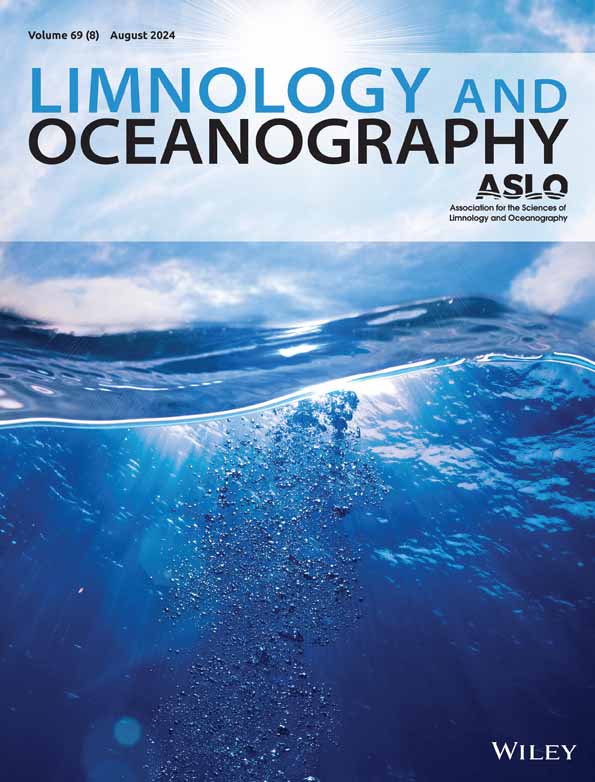营养脉冲情景驱动淡水浮游植物功能稳定性的对比模式
IF 3.8
1区 地球科学
Q1 LIMNOLOGY
引用次数: 0
摘要
气候变化正在增加极端天气事件的频率、强度和随机性,如强降雨、风暴引起的混合天气或延长的干旱期。这导致湖泊中溶解营养物和碳的变化更大,并引起浮游生物群落资源可得性的时间波动,这可能进一步导致生长和碳、氮和磷等基本元素的细胞比例的变化。然而,目前对降水事件的规律性和频率变化对生产者和消费者水平的影响的理解受到缺乏在多个营养水平检查过程的实验研究的限制。在我们的介质研究中,我们以不同的频率(每日、间歇或一次极端添加)和规律(规则、不规则)的脉冲向每个介质中添加相同总量的硝酸盐、磷酸盐和彩色溶解有机质(cDOM),模拟径流期,然后是恢复期。结果表明,在一个极端的养分和cDOM脉冲控制条件下,浮游植物生物量完全恢复,而更高频率的脉冲逐渐增加生物量。在化学计量学方面,极端脉冲导致颗粒C: P和N: P比的稳定性最低。在浮游动物水平上,桡足类生物量在所有营养物质和cDOM添加的情况下都有所下降,但在处理之间没有发现影响。总体而言,我们的研究表明,浮游植物的稳定性取决于营养物质添加的规律性和频率,并且在生物量和化学计量之间存在很大差异,但浮游动物水平的影响可能会得到缓冲。本文章由计算机程序翻译,如有差异,请以英文原文为准。
Nutrient pulse scenarios drive contrasting patterns in the functional stability of freshwater phytoplankton
Climate change is increasing the frequency, intensity, and stochasticity of extreme weather events such as heavy rainfall, storm‐induced mixing, or prolonged drought periods. This results in more variable regimes of dissolved nutrients and carbon in lakes and induces temporal fluctuations in the resource availability for plankton communities, which can further lead to changes in growth and the cellular ratio of essential elements, such as carbon, nitrogen, and phosphorus. However, the current understanding of the effects of variations in regularity and frequency of precipitation events on both producer and consumer levels is limited by the lack of experimental studies examining processes at multiple trophic levels. In our mesocosm study, we added the same total amount of nitrate, phosphate, and colored dissolved organic matter (cDOM) to each mesocosm at pulses differing in frequency (daily, intermittent, or one extreme addition) and regularity (regular, irregular) over a simulated run‐off period followed by a recovery period. Our results showed that phytoplankton biomass fully recovered to control conditions from one extreme nutrient and cDOM pulse, whereas pulses of higher frequency gradually increased the biomass. In terms of stoichiometry, the extreme pulse led to the lowest stability in particulate C : P and N : P ratios. At the zooplankton level, copepod biomass decreased across all nutrient and cDOM additions, but no effects between the treatments were found. Overall, our study demonstrates that phytoplankton stability depends on the regularity and frequency of nutrient additions and differs substantially between biomass and stoichiometry, but the effects may be buffered on zooplankton level.
求助全文
通过发布文献求助,成功后即可免费获取论文全文。
去求助
来源期刊

Limnology and Oceanography
地学-海洋学
CiteScore
8.80
自引率
6.70%
发文量
254
审稿时长
3 months
期刊介绍:
Limnology and Oceanography (L&O; print ISSN 0024-3590, online ISSN 1939-5590) publishes original articles, including scholarly reviews, about all aspects of limnology and oceanography. The journal''s unifying theme is the understanding of aquatic systems. Submissions are judged on the originality of their data, interpretations, and ideas, and on the degree to which they can be generalized beyond the particular aquatic system examined. Laboratory and modeling studies must demonstrate relevance to field environments; typically this means that they are bolstered by substantial "real-world" data. Few purely theoretical or purely empirical papers are accepted for review.
 求助内容:
求助内容: 应助结果提醒方式:
应助结果提醒方式:


